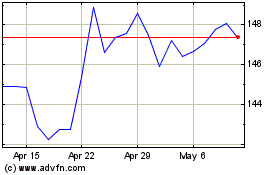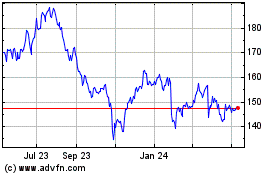UPS to Add Delivery Surcharges for Holiday Orders -- Update
20 June 2017 - 5:47AM
Dow Jones News
By Paul Ziobro
Holiday shopping is about to get more expensive.
United Parcel Service Inc. for the first time will tack a
surcharge onto most online orders shipping around the Black Friday
shopping weekend and the week before Christmas. It is the latest
attempt by the large delivery company to recoup the massive
increase in hiring and reserving extra trucks and planes during the
busiest times.
The changes have retailers, which are struggling to adapt to a
world where more people shop online, facing the prospect of either
eating the higher charge or trying to recoup it by raising
prices.
UPS on Monday said the surcharge will be 27 cents a package for
all ground shipments to homes sent between Nov. 19 and Dec. 2,
which includes some of the busiest online shopping days. Ground
orders typically arrive within five days and are a heavily used
shipping option during that time since shoppers don't necessarily
need the items quickly.
The peak surcharges won't be in effect for the following two
weeks, when shoppers typically take a pause, but they will return
for the final holiday rush. From Dec. 17-23, UPS will charge an
extra 27 cents for each ground shipment, 81 cents for next-day air
and 97 cents for two- or three-day delivery.
The charges apply only to residential deliveries, so retailers
and shoppers may be able to avoid the charges by getting orders
shipped to stores, an option retailers have been pushing for the
past few years with varying success.
UPS's main rival, FedEx Corp., doesn't have a surcharge during
the holidays, although the two carriers often match each other on
pricing moves. A spokesman for FedEx, which is scheduled to report
earnings Tuesday, declined to comment.
Chief Commercial Officer Alan Gershenhorn said the per-package
cost will only "marginally increase" during this time. As an
example, UPS said a five-pound next-day air package from Atlanta to
Philadelphia will cost 1% more to ship.
The surcharge, however, will provide a big haul to UPS, whose
daily volume swells to more than 30 million in the weeks before
Christmas versus more than 19 million on a normal day. Citi
Research estimates the new surcharges will add $50 million in
revenue and profit at UPS this year. The carrier declined to
provide a projection on the revenue impact from the surcharges, but
said it was already factored into its outlook.
Shippers may try to avoid the surcharge by offering more deals
in October and early November, or by negotiating a discount. "The
real objective for the surcharge is to motivate shippers to do
their part in avoiding such volume increases," said Satish Jindel,
president of ShipMatrix Inc., a software provider that analyzes
shipping data.
UPS, FedEx and the U.S. Postal Service are all looking to recoup
massive investments the are making in their delivery infrastructure
to accommodate the surge of packages flowing into their networks in
recent years as more people shop online. UPS is spending $4 billion
this year alone as it automates more package-sorting hubs and opens
new warehouses.
"They're just trying to make sure they're, at the margin,
getting compensated for stretching their network," Sanford C.
Bernstein analyst David Vernon said, adding that the carriers have
the power to raise prices given how critical they have become to
the period. "Without them, Christmas kind of doesn't happen."
UPS is looking at other ways to recoup costs during peak
periods, so it isn't left holding the bag for the additional
investments. Last month, UPS Chief Executive David Abney said the
carrier is negotiating with retailers to help them pay for the any
additional investments, even it goes unused.
On Monday, UPS said will also impose surcharges on all large
packages above a certain threshold, which cost more to ship and
sort, throughout the entire period. Those surcharges will be more
onerous, tacking an additional $24 fee to a normal surcharge of $70
for a package weighing more than 150 pounds and over a certain
size. UPS also will charge a peak surcharge of $249 per package on
the largest packages, on top of a $150 fee for such "overmax"
packages.
The company is encouraging shippers to instead send such
packages through its freight network, where it recently imposed a
second 4.9% increase in the past year.
Write to Paul Ziobro at Paul.Ziobro@wsj.com
(END) Dow Jones Newswires
June 19, 2017 15:32 ET (19:32 GMT)
Copyright (c) 2017 Dow Jones & Company, Inc.
United Parcel Service (NYSE:UPS)
Historical Stock Chart
From Mar 2024 to Apr 2024

United Parcel Service (NYSE:UPS)
Historical Stock Chart
From Apr 2023 to Apr 2024
